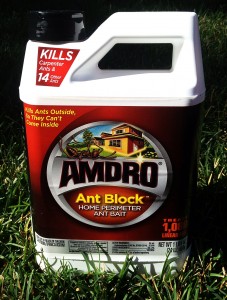As an environmental professional who works in the hazardous materials field, I understand the power of a good toxin: both good and bad. As a homeowner with a yard that has an abundance of bugs and weeds, I try to find a balance between pesticide and herbicide use…and abuse.
Glyphosate is first on my mind. If you’re not sure what it is, let me tell you it’s more common name – Roundup. It’s one of, if not the most used herbicide for both industrialized agriculture and homeowners.
After spending hours during the spring and early summer hand pulling weeds, I broke down and sprayed the ground vines in my front and side mulch beds and it worked. I did not spray the backyard or the garden plot. That is where my family and dogs spend all of our time outside. We don’t hang out in the front yard.
I’m trying to find the balance between the toxin, my family and dog’s health, the out of control weeds, and the amount of time I have to spend hand pulling weeds. This is where I will apply the equation, Risk = Hazard x Exposure. I’m using a toxin, so I have both the hazard and exposure. My risk therefore can’t = 0. Now I have to manage the risk. I minimize the risk by limiting my exposure, which means only spraying the areas that I don’t spending much time around.
One issue with this is that weeds are not a primary hazard. It’s not like a wasp nest, mosquitoes, or carpenter ants that could harm my health or my home. Weeds are a merely a nuisance. So is it worth it to use the herbicide only for aesthetics?
 Back to the toxin. Glyphosate is considered non-carcinogenic and can be transmitted to humans orally or through absorption. So wear gloves, wash your hands when you’re finished applying it, don’t walk through the applied area for hours after, and take off your shoes before you enter your house. It is considered low toxicity, does not bioaccumulate, and breaks down over days to weeks. It can build up in the storm water if over-applied or applied right before a storm. I fear it is over-applied quite often, particularly in commercial areas.
Back to the toxin. Glyphosate is considered non-carcinogenic and can be transmitted to humans orally or through absorption. So wear gloves, wash your hands when you’re finished applying it, don’t walk through the applied area for hours after, and take off your shoes before you enter your house. It is considered low toxicity, does not bioaccumulate, and breaks down over days to weeks. It can build up in the storm water if over-applied or applied right before a storm. I fear it is over-applied quite often, particularly in commercial areas.
I’ll keep using glyphosate sparingly to control the weeds and I’ll always remain conscious of its toxicity. The small changes you make at home will benefit your immediate health and well-being. Until there are big policy and/or industrial changes, glyphosate will still end up in our storm water and other places we don’t want.
Limit your exposure to pesticides and herbicides to the minimum amount necessary to control the hazard from the pests and nuisance plants. The exposure to the pest can be worse than the exposure to the toxin. This article from the Environmental Working Group explains how the exposure to DEET is not as bad as being exposed to mosquito borne diseases, such as malaria, west nile virus, or zika.



